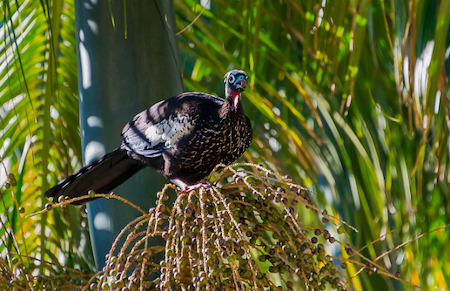 Evolution & Behaviour
Evolution & Behaviour
Humans are affecting the evolution of animals and plants
Species on Earth are interconnected to each other through ecological interactions. Human activities can erode those connections, leading to the loss of millions of years of evolutionary history, with unknown consequences for ecosystems’ functioning.

Like in a theatre where actors interact to perform the script of a given play, species on Earth interact with each other in an ecological arena, interpreting millions of years of evolution. The famous ecologist G.E. Hutchinson made that analogy back in 1965, calling attention for the environmental influence on evolutionary processes. As evolution determines which species can interact, likewise ecology must influence the evolutionary trajectory of the interacting partners. As such, some species establish beneficial relationships with their partners, performing mutualistic interactions as the product of millions of years of evolution. Pollination and seed-dispersal are good examples of this play, in which plant and animal species are the actors. They interact according to a given ecological scenario, and to their evolutionary history that favored some traits over the others. When we observe a bee pollinating a flower, or a bird eating fruit and afterward dispersing its seeds, we are watching a play. In this play, millions of years of combined evolutionary trajectories are interacting in the contemporaneous ecological arena.
Humans are a new character in this play, though. Nevertheless, we are so influential on Earth that the current era is called Anthropocene. Man-made impacts such as climate change or irreversible biodiversity loss have defined a new geological epoch. Defaunation stands as one of the leading causes of species loss. Although species go extinct with a certain pace over the evolutionary time, we are speeding-up that process, acting as the very meteor that killed the dinosaurs.
In tropical forests, up to 94% of the plant species depend on mutualistic interactions with animals to complete their life cycle. One crucial step is seed-dispersal, in which birds are very efficient by moving seeds to safety sites where plants can germinate and grow. Here, defaunation plays an essential role by primarily affecting birds, and consequently, the interactions they perform. Large-sized plant and bird species tend to be older and more distinct in their phylogenetic tree. They carry a unique set of genetic, evolutionary, and ecological information that may not survive the challenges imposed by human-driven disturbances. As a consequence, when an interaction is removed from the scene, it takes with it millions of years of evolutionary history as well.
In the Atlantic Forest of Brazil - a highly threatened hotspot of biodiversity - defaunation is removing the most evolutionarily distinct interactions from the stage. Millions of years of evolution are vanishing as the highly evolutionarily distinct bird species that disperse highly evolutionarily distinct plant species are disappearing. An example is the interaction between the highly hunted Black-fronted Piping-guan (Pipile jacutinga, 29 Ma), and the "juçara" palm (Euterpe edulis, 99 Ma) a keystone species also threatened by illegal harvesting. Combined, the Pipile-Euterpe interaction, nowadays only found in pristine, large forest tracts, carries 130 Ma of unique evolutionary history that has been extirpated from the landscape. In this new human-made fragmented scenario, the persisting interactions are performed by small-sized, generalist bird species dispersing small-seeded plant species. Yet, sometimes, unexpected associations arise. For instance, relatively recent birds on the Tree of Life are saving ancient plants, by dispersing seeds of species that have lost their primary mutualistic partner, and that would have been out of the scene otherwise.
Today, defaunation is increasing in most tropical forests. This trend will cause a marked reshaping of the Tree of Life because of bird-driven losses that cannot be replaced by contemporaneous species. Furthermore, an increase of CO2 may happen due to large-seeded plants going extinct with their large-bodied seed-dispersers.
In a more favorable setting, active restoration of the evolutionary history of threatened interactions by reintroducing one or both partners could potentially minimize the losses. Concomitantly small-generalist bird species may be rescuing highly evolutionarily distinct plant species from the verge of extinction.
Original Article:
Emer C, Galetti M, Pizo M, Jordano P, Verdú M. Defaunation precipitates the extinction of evolutionarily distinct interactions in the Anthropocene. Sci Adv. 2019;5(6):eaav6699.Edited by:
Massimo Caine , Founder and Director
We thought you might like
More from Evolution & Behaviour
Cicada emergence alters forest food webs
Jan 31, 2025 in Evolution & Behaviour | 3.5 min read by Martha Weiss , John LillSize does not matter: direct estimations of mutation rates in baleen whales
Jan 29, 2025 in Evolution & Behaviour | 4 min read by Marcos Suárez-MenéndezThe Claws and the Spear: New Evidence of Neanderthal-Cave Lion Interactions
Jan 22, 2025 in Evolution & Behaviour | 3.5 min read by Gabriele RussoA deep-sea spa: the key to the pearl octopus’ success
Jan 20, 2025 in Evolution & Behaviour | 3.5 min read by Jim BarryFeisty fish and birds with attitude: Why does evolution not lead to identical individuals?
Aug 31, 2024 in Evolution & Behaviour | 3 min read by Lukas Eigentler , Klaus Reinhold , David KikuchiEditor's picks
Trending now
Popular topics


